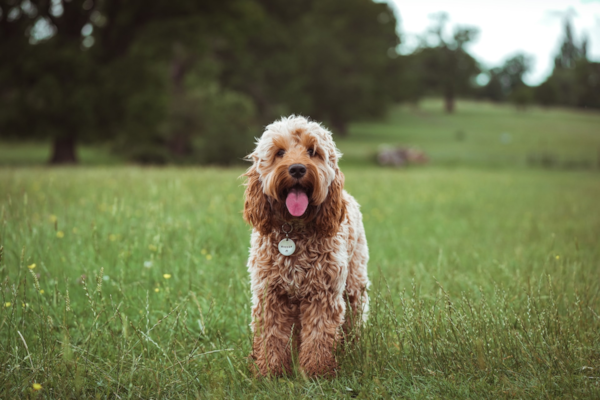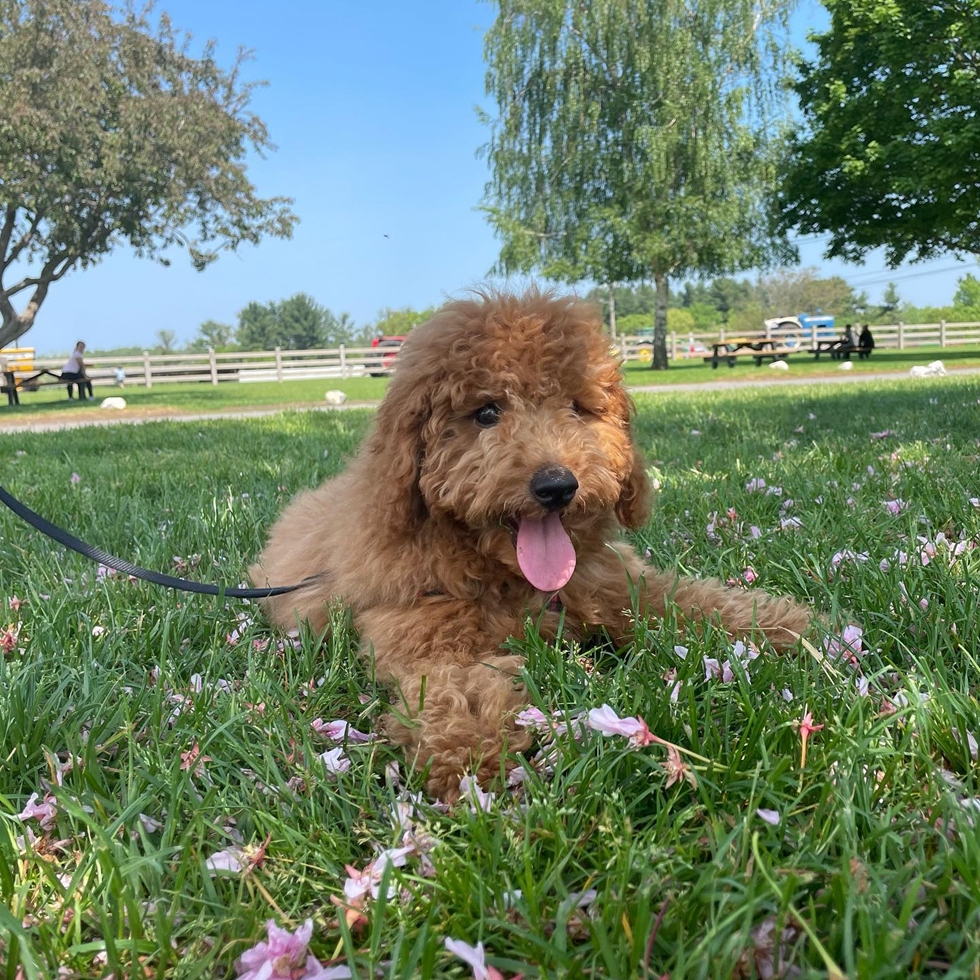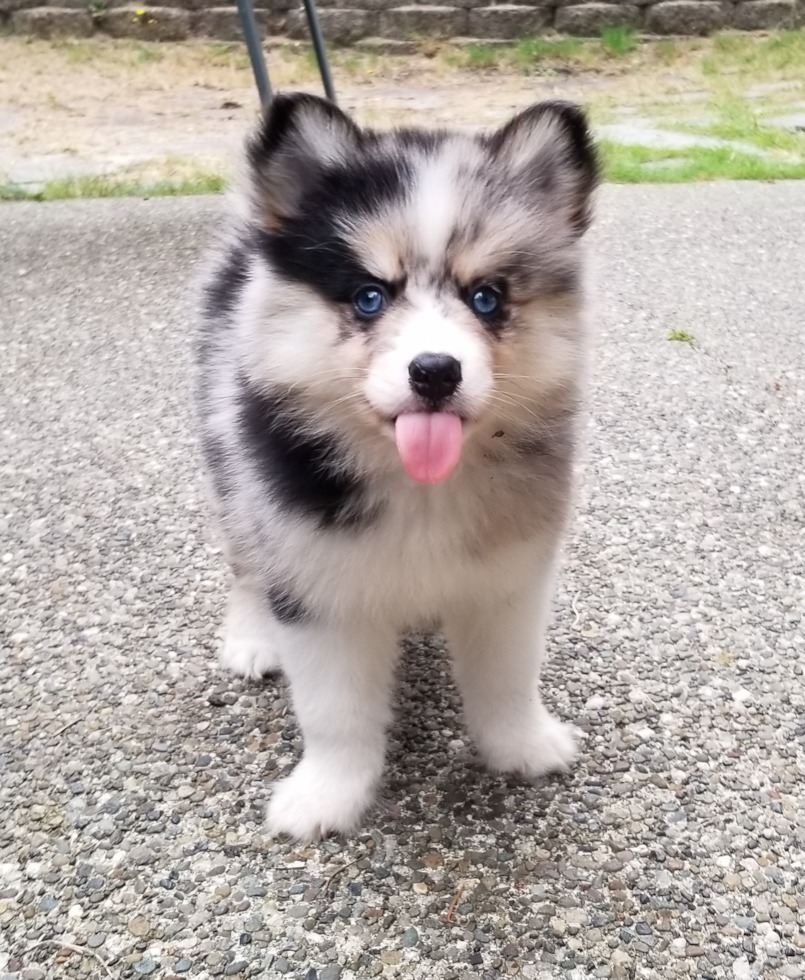
Since their first paw-steps into the world, Designer-mixed Breeds have conquered the canine popularity charts with their unique appearance, fantastic personalities, and hypoallergenic qualities. Designer Breeds come in all shapes and sizes, personality types, and temperaments.
According to individual preferences and for better control over their size, coat textures and colors, features, and personality traits, Doodle Breeds (like the Cavapoo, Mini Labradoodle, Cockapoo, Mini Goldendoodle, etc.), as well as, Designer-mixed Breeds (such as the Pomsky and more), are often times bred into one of three generations: F1, F1B, and F2.
Table of Contents
F1, F1B and F2 Mixed Breed Generations Overview

F1 Mixed Breed Generation
An F1 crossbreed, known as a first-generation crossbreed, is when a puppy has two different purebred parents. This means that a first-generation puppy will be a 50/50 mix of his parent breeds. For example:
- An F1 Mini Goldendoodle, a cross between a purebred Golden Retriever and a purebred Mini Poodle, will be 50% Golden Retriever and 50% Mini Poodle.
- An F1 Cockapoo, a cross between a purebred Cocker Spaniel and a purebred Mini Poodle, will be 50% Cocker spaniel and 50% Mini Poodle.
- An F1 Pomsky, a cross between a purebred Pomeranian and a purebred Siberian Husky, will be 50% Pomeranian and 50% Siberian Husky.
F1B Mixed Breed Generation
An F1B crossbreed, known as a second-generation crossbreed or a first-generation back cross, is when an F1 is bred back to one of the purebred parent breeds. This means that a second-generation puppy will be a 25/75 mix of his parent breeds. For example:
- An F1B Mini Goldendoodle is the result of an F1 Mini Goldendoodle bred back to either a Golden Retriever or a Miniature Poodle. An F1B Mini Goldendoodle will be 25% Golden Retriever and 75% Mini Poodle or, in some rare cases, 25% Mini Poodle and 75% Golden Retriever.
- An F1B Cockapoo is the result of an F1 Cockapoo bred back to a Cocker Spaniel or a Mini Poodle. An F1B Cockapoo will be 25% Cocker Spaniel and 75% Mini Poodle or, in some rare cases, 25% Mini Poodle and 75% Cocker Spaniel.
- An F1B Pomsky is the result of an F1 Pomsky bred back to either a Pomeranian or Siberian Husky. An F1B Pomsky puppy can be 25% Pomeranian and 75% Siberian Husky or 25% Siberian Husky and 75% Pomeranian (depending on the desired traits and features).
More often than not, the Poodle who is a non-shedding, hypoallergenic breed is the preferred parent for the F1B Doodle puppies. This means that in most F1B Doodle mixes, the F1 is backcrossed with a Poodle.
F2 Mixed Breed Generation
An F2 crossbreed, known as a third-generation crossbreed, is when a puppy has two F1 crossbreed parents. If the two F1’s are very different it becomes very difficult to predict which original purebred parent the F2 puppy will take after. In this case, the F2 puppy can inherit more features and traits from one parent breed and very few from the other. If the two F1’s take more after the same breed, then the F2 will possibly turn out the same.
F1 vs F1B vs F2 Mixed Breed Generation Comparison
The main difference between the F1, F1B, and F2 generations is how much they inherit from their parent breeds. An F1 puppy is an even mix of his parent breeds, whereas an F1B puppy takes after one of his parent breeds more than the other. Unlike the F1 and F1B puppies, the F2 puppy is hard to predict in terms of genetics if the F1 parent breeds are dissimilar.
Another aspect that sets the F1, F1B, and F2 apart is hybrid vigor. Although all three generations benefit on some level from hybrid vigor, the F1 puppy is likely to benefit the most because of his first-generation status. When a new gene pool is added to the mix, genetics play their part and create a healthier pup. This means that an F1 puppy is healthier than his purebred parents, and is unlikely to inherit any health problems that his parents generally pass down to their purebred offspring.
Shedding and hypoallergenic qualities also play a major role in determining which generation is right for certain pet owners. Typically, all three generations have low-shedding coats and hypoallergenic qualities, with the F1B being the most allergy-friendly and the F1 a better fit for owners suffering from mild pet-related allergies. Generally, Doodle Breeds, which are a cross between a Poodle and a different breed, regardless of their F1, F1B, or F2 status, are more likely to be hypoallergenic as opposed to some of the Designer-mixed breeds that don’t share a Poodle parent.
F1, F1B and F2 Mixed Breed Generation Temperament

F1 Mixed Breed Generation Temperament
F1 puppies inherit personality traits in equal measure from both of their parent breeds. For example:
An F1 Pomsky has a perfectly balanced combination of Pomeranian and Siberian Husky personalities, temperaments, and behaviors. The F1 Pomsky puppy will be just as playful, loving, and friendly as both of his parent breeds.
F1B Mixed Breed Generation Temperament
F1B puppies inherit more personality traits from one of their parent breeds. For example:
An F1B Mini Goldendoodle that is a cross between an F1 Mini Goldendoodle and a Mini Poodle will have some of the Golden Retriever qualities and more of the Poodle’s personality. Being 25% Golden Retriever and 75% Poodle, the F1B Mini Goldendoodle will inherit the intelligence and agility of his Poodle parent, and the friendliness and goofy nature of his Golden Retriever parent.
F2 Mixed Breed Generation Temperament
If F2 puppies are a cross between two F1 parents that are very similar personality-wise, then it is possible that they will inherit the same temperaments and personalities of their parent breeds. If F2 puppies are a cross between two very different F1 parents, their personality, temperament, trainability, and so on, become difficult to predict.
F1 vs F1B vs F2 Mixed Breed Generation Temperament Comparison
The main difference between the F1, F1B, and F2 puppies is noted in how much they take after their parent breeds. An F1 will be an even mix of parent breed personalities, an F1B will be more like one parent breed than the other, and the F2 puppies will either be unpredictable in terms of personality or possibly similar to their F1 parents.
When it comes to comparing F1, F1B, and F2 temperaments and personalities, pet owners are met with three options that align with their preferences.
The first option is when potential pet-owners are fond of two different breeds in equal measure and can’t decide on which one to take home. The F1 puppy is the winner and the best option in this case because of his 50/50 parent breed personality inheritance.
The second option is when pet-owners want the personality of one of the parent breeds to dominate but also desire a few traits from the second parent breed. In this case, the F1B puppy is the best option.
The third option is a fun lottery. The F2 puppies are a great option for those who love two breeds in equal measure and are impartial to which breed they take after more.
F1, F1B and F2 Mixed Breed Generation Appearance

F1 Mixed Breed Generation Appearance
First-generation puppies have combined features of both parent breeds. For example:
An F1 Cockapoo that is 50% Cocker Spaniel and 50% Mini Poodle will resemble both parent breeds. A fully grown F1 Cockapoo will likely combine the often straight Cocker Spaniel coat with the curly Poodle coat and have a wavy-in-between coat texture. The same theory applies to size, coat colors, features, and weight.
F1B Mixed Breed Generation Appearance
Second-generation puppies inherit more physical traits from one parent breed. For example:
An F1B Pomksy that is 25% Pomeranian and 75% Siberian Husky will resemble his Husky parent more. In this case, the F1B Pomsky will have a combination of desired features (blue eyes, wolfish appearance, sturdy body) from the Siberian Husky and the small size of the Pomeranian. The F1B Pomsky puppy is also likely to inherit the Husky coat texture as well as coat colors and shedding.
F2 Mixed Breed Generation Appearance
Third-generation puppies can either inherit the same appearance as their similar F1 parents or be unpredictable. For example:
An F2 Mini Goldendoodle that has almost identical looking F1 parents will likely inherit their same features, size, coat type, and weight.
An F2 Mini Goldendoodle with two very different looking F1 parents is unpredictable in terms of appearance, size, coat colors, and weight.
F1 vs F1B vs F2 Mixed Breed Generation Appearance Comparison
These three crossbreed generations are quite different when it comes to their size and appearance. The F1 crossbreed resembles both parent breeds equally, whereas the F1B tends to resemble one of its parent breeds more. Unlike the F1 and the F1B, the F2 crossbreed is more often than not unpredictable when it comes to physical characteristics.
Scroll down to see FAQs about f1, f1b, and f2 hybrid generations!
What To Read Next
The 5 Most Popular Mini Doodles
Doodle Dogs Explained – Part 2
Frequently Asked Questions
What is the difference between F1, F1B, and F2 dog breed generations? F1, F1B, and F2 refer to different generations of crossbred dogs. An F1 puppy is a first-generation crossbreed with two different purebred parents, meaning it's a 50/50 mix of their parent breeds. An F1B puppy is a second-generation crossbreed, resulting from an F1 crossbreed bred back to one of the purebred parent breeds, making it a 25/75 mix of its parent breeds. An F2 puppy is a third-generation crossbreed, produced when two F1 crossbreeds are bred together.
Is an F1 dog better than an F2? The health and temperament of a dog can't be determined solely based on whether it's an F1 or F2 crossbreed. However, F1 puppies often benefit the most from hybrid vigor, meaning they're generally healthier than their purebred parents and less likely to inherit specific breed-related health issues. F2 puppies can inherit traits more unpredictably, which can be a positive or negative depending on the traits in question.
What does F1B mean in dogs? F1B refers to a second-generation crossbreed or a first-generation backcross. This happens when an F1 crossbreed is bred back to one of the purebred parent breeds. This results in a puppy that is a 25/75 mix of its parent breeds. For example, an F1B Mini Goldendoodle will be 25% Golden Retriever and 75% Mini Poodle.
What is the meaning of F2 in dog breeding? F2 refers to a third-generation crossbreed, produced when two F1 crossbreeds are bred together. The traits that an F2 puppy inherits can be more unpredictable, especially if the F1 parents are very different from each other. This can result in a wider range of possible sizes, coat types, and temperaments in F2 puppies.



